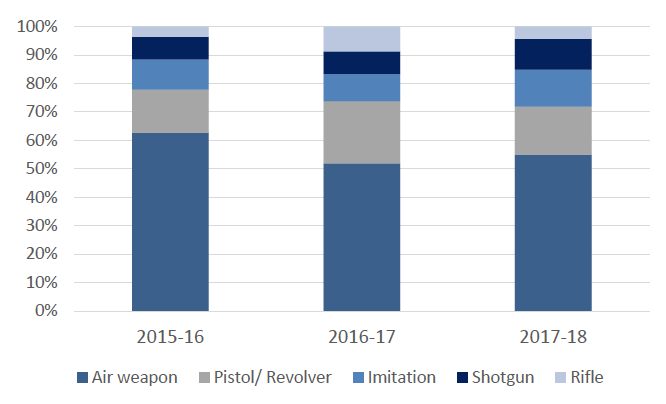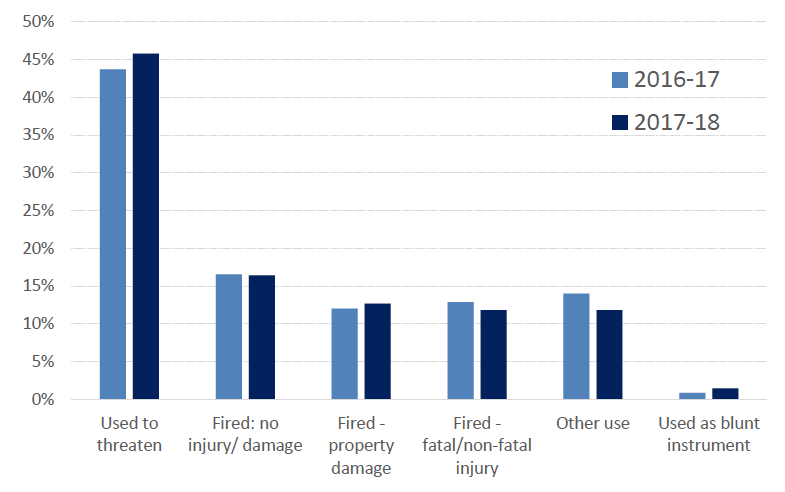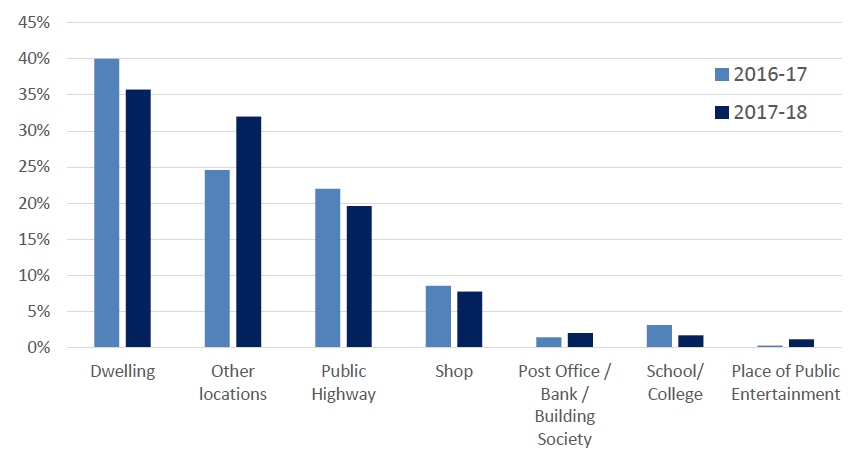Recorded crimes and offences involving firearms: 2016-17 and 2017-18 statistics
Statistics on crimes and offences recorded by the police in Scotland in which a firearm was alleged to have been involved or where a firearm was stolen.
This document is part of a collection
2. Commentary
2.1 Offences involving firearms (Tables 1, 2, 2a, 3 and 4, and Chart1)
- In 2016-17, the police in Scotland recorded 350 offences in which a firearm was alleged to have been involved, a decrease of 13% since 2015-16. In 2017-18, the police recorded 348 offences, a decrease of 1% from 2016-17. This is the lowest number of recorded offences since 1980.
- In 2017-18, 18% of recorded offences involving a firearm were for Possessing a firearm with intent to endanger life, commit crime etc.. A further 17% of total recorded offences were for breach of the peace etc., 14% were for Common assault and 11% were for Reckless conduct with firearms.
- In 2016-17, a single Homicide involving a firearm was recorded, with two recorded in 2017-18. There were eight Attempted murders involving a firearm in 2016-17 and ten in 2017-18.
- The number of Serious assaults involving a firearm increased by three offences from five in 2016-17 to eight in 2017-18. The number of robberies involving a firearm recorded in 2017-18 was 34, an increase of three from 2016-17.
- When air weapons and unidentified weapons are excluded, the total number of offences involving a firearm decreased by 14% between 2016-17 and 2017-18 (from 177 offences to 153 offences).
- Offences relating to Possessing a firearm with intent to endanger life, commit crime etc. and Breach of the peace etc. continue to account for the largest proportion of offences involving a firearm when air weapons and unidentified weapons are excluded (at 18% and 15% of offences, respectively), discounting the ‘other’ offence category.
- The use of firearms in criminal activity continued to constitute only a small proportion of all offences recorded by the police in 2017-18, including 3.4% of Homicides (two offences), 4.1% of Attempted Murders (ten offences) and 2.2% of Robberies (34 offences). Only 0.2% of all Serious assaults, and less than 0.1% of all Common assaults, and all Vandalism offences involved the alleged use of a firearm. For further information please see Note 3.8.2.
2.2 Main firearm recorded (Tables 4, 4a and 5, and Chart 1)
- An air weapon was used in just over one-third (36%, or 127 offences) of all offences involving a firearm in 2017-18, slightly up from 34% (119) in 2016-17. When unidentified and other firearms are excluded, air weapons were used in 55% of offences in 2017-18. Over the last three years, the number of offences involving an air weapon fell by one-third (from 190 to 127 offences).
- Between 2016-17 and 2017-18, the number of offences involving shotguns (+7, or 39%), imitation firearms (+8, or 36%), unidentified firearms (+14, or 26%), and air weapons (+8, or 7%) increased, while the number of offences involving rifles (-10, or 50%), pistols/revolvers (-11, or 22%) and other firearms (-18, or 27%) decreased.
- In general, an air weapon was the most common weapon used – including for crimes of Vandalism (79%), Reckless conduct with a firearm (59%) and Common assault (57%).
- Offences where air weapons were not the most common include those relating to Possessing a firearm with intent to endanger life, commit crime etc. (23%) and Robbery (15%). Pistols/revolvers were more common than air weapons in Robberies (29%), and equally common in offences of Possessing a firearm with intent to endanger life, commit crime etc. (both on 23%).
- Chart 1 shows the type of weapon used in each offence as a proportion of the total number of offences recorded in each year (excluding unidentified and other firearms). It shows that in 2017-18, 55% off offences involved the use of an air weapon.
Chart 1: Main firearm recorded in offences involving the alleged use of a firearm, as a percentage of recorded offences (exc. Unidentified and other firearms), Scotland, 2015-16 to 2017-18

2.3 Firearm use (Tables 6, 6a, 7, 8, 9 and 9a, and Chart 2)
- 348 (or 46%) of the recorded offences in 2017-18 involved a firearm being used to threaten. A firearm was discharged in 41% of offences. The breakdown of how the main firearm recorded was used is provided in Chart 2.
- The small decrease in the total number of offences involving firearms between 2016-17 and 2017-18 was not driven by any significant changes in a particular method of how the firearm was used. The biggest change was observed amongst ‘other use’ offences which decreased by 16% from 49 in 2016-17 to 41 in 2017-18.
- There were small changes in every other category. Some had small increases, such as fired – fatal injury (+1), fired – property damage (+2), used as a blunt instrument (+2), and used to threaten (+6). Other categories saw small decreases, e.g. fired – non-fatal injury (-3), fired – no injury / damage (-2), and other use (-8).
- The number of offences in which a firearm was fired and caused fatal or non-fatal injury to a person decreased by 5% from 43 in 2016-17 to 41 in 2017-18. For more information regarding the method of counting victims, see Note 3.8.5.
- The number of offences in which a firearm was discharged causing no injury or damage decreased by two offences from 59 in 2016-17 to 57 in 2017-18 (-3%). Crimes where property was damaged increased by two offences from 43 in 2016-17 to 45 in 2017-18 (+5%).
- Of the 143 offences in which a firearm was discharged in 2017-18, 56% (80) involved an air weapon, of which none resulted in fatal injury. Of those 80 offences, 32 resulted in no injury or damage, 26 in property damage, and the remaining 22 in a non-fatal injury to a person.
- Of the 49 Common assaults involving a firearm in 2017-18, 17 resulted in the weapon being discharged and causing a non-fatal injury. This accounts for nearly half (45%) of the 38 recorded offences in which a firearm was fired and caused a non-fatal injury.
- Where a firearm was discharged resulting in no injury, one-third (19 offences) of these instances were classified as Reckless Conduct With a Firearm. Where a firearm was used to threaten, just over one-third (34%) of these were offences of Possessing a firearm with intent to endanger life, commit crime etc..
Chart 2: How main firearm recorded was used in offences involving the alleged use of a firearm, as a percentage of total offences, Scotland, 2016-17 and 2017-18

2.4 Location of firearm offences (Tables 10 and 10a, and Chart 3)
- In 2017-18, most offences involving firearms either took place in a dwelling (36%) or other locations (32%). Other locations include: within a motor vehicle, licensed premises, and other outside locations i.e. a field.
- Between 2016-17 and 2017-18, the number of offences occurring in certain locations increased. ‘Other’ locations (+26), places of public entertainment (+3), post offices (+1), and banks/building societies (+1) all saw an increase.
- The number of offences occurring in a dwelling (-16), public highway (-9),
school/college (-5), and shop (-3) all decreased from 2016-17 to 2017-18.
Chart 3: Location of offences involving the alleged use of a firearm, as a percentage of total offences, Scotland, 2016-17 and 2017-18

1. Public highway includes roads and footpaths.
2. Shop includes shops, stalls, stores, offices and factories
3. Other locations include: within a motor vehicle, on licensed premises, and other outside locations i.e. a field
- In 2017-18 there were six offences that occurred in a school or college involving the alleged use of a firearm. This represents a 45% decrease from the previous year, when 11 offences were recorded in 2016-17. In total, seven offences involving the alleged use of a firearm occurred within a bank, building society or post office in 2017-18, with a further four in places of public entertainment in 2017-18.
- An air weapon was the only type of weapon used in offences that occurred within a School/College, Bank, Building society or Place of public entertainment in 2017-18.
2.5 Victim characteristics (Tables 11 and 11a)
- Details on the way that victims are counted within this bulletin are provided in Note 3.8.5.
- Of the 41 main victims who were either fatally or non-fatally injured during an offence involving a firearm in 2017-18, 33 were male (80%) and 8 were female (20%).
- The number of offences that included a male main victim increased by five (+18%) between 2016-17 and 2017-18, while the number of offences that included a female victim decreased by five (-38%).
- The number of offences with a main victim decreased by two from 2016-17 to 2017-18. This decrease comes from the number of offences with an unknown victim, where there were two in 2016-17 and none in 2017-18.
- In 2017-18, the median age of victims was 23. 39% of all offences where someone was either fatally or non-fatally injured involved a victim under the age of 16. There were 20 offences that had a main victim aged 31 or older, accounting for 49% of offences with a main victim.
- When air weapons and unidentified weapons are excluded, there were 13 offences with a main victim in 2017-18, a 59% decrease from 32 in 2016-17.
- For data that specifically relates to the number of homicide fatalities involving the use of a firearm, please refer to the National Statistics for Homicide in Scotland 2017-18.
2.6 Clear up rates (Table 12)
- In 2017-18, 69% of all offences involving a firearm were cleared up. For further information on clear up rates please see Note 3.7.
- There were large variations in the clear-up rate across the different crime groups in 2017-18. Some crime groups - Homicide (100%), Serious assaults (100%) and Common assaults (86%) - had relatively higher clear-up rates. The clear-up rate was relatively lower for other crime groups, including Breach of the peace etc. (75%), Reckless conduct with a firearm (62%), Attempted murder (60%), and Robbery (53%). Vandalism had a clear-up rate of 14%, with two of 14 incidents were cleared up in 2017-18.
2.7 Accused characteristics (Table 13)
- In 2017-18, there were 241 offences in which an accused person has been identified. Of these 241, 93% (or 224) were male, while only 7% (or 17) were female.
- In 2017-18 the median age of an accused person was 28. The main accused was under 16 years old in 12% of cleared up offences involving the use of a firearm (29 out of 241 offences). A further 17% of cleared up offences were committed by an accused aged 16 to 20 years (41 offences). Of all offences that were cleared up in 2017-18, the most common ages of the main accused was those aged over 41 years and 21-30 years, with 67 and 65 offences respectively (28% and 27% of all offences cleared up).
2.8 Offences in local authorities (Tables 15, and 15a)
- When considering the trends in the number of offences in which a firearm was alleged to have been used in each local authority area, it should be noted that most local authority areas have relatively small counts of firearm offences. As a result, small changes in the number of offences in which a firearm was alleged to have been used can lead to large changes in percentage terms.
- In 2017-18, the local authority areas of Glasgow City (64), South Lanarkshire (35) and North Lanarkshire (28) had the highest number of offences involving firearms. When cases involving air weapons are excluded – the highest number of offences were recorded in Glasgow City (20), Aberdeen City (18), South Lanarkshire (15), and Aberdeenshire (15).
2.9 Stolen firearms (Table 16 and 16a)
- During 2017-18, Police Scotland recorded 14 offences in which a firearm (other than an air weapon) was stolen (an increase from seven offences in 2016-17).
2.10 Miscellaneous firearm offences (Table 17 and 17a)
- The number of miscellaneous firearm offences recorded by the police, relating mainly to the possession, handling and distribution of firearms and ammunition, fell from 426 in 2016-17 to 398 in 2017-18 (-7%). This continues an overall downward trend since 2008-09, with 2017-18 having the lowest number of miscellaneous firearm offences over the previous ten years. For further information on these Miscellaneous firearm offences, please see Note 3.5.1.
- 2017-18 was the first full reporting year following the introduction of the air weapons licensing legislation in Scotland. There were a total of 396 recorded offences under this Act in 2017-18. The legislation was only in place for part of 2016-17 (January to March) during which 55 offences were recorded.
Contact
Email: Stuart.Napier@gov.scot
There is a problem
Thanks for your feedback